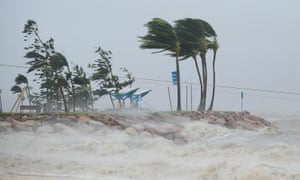CSIRO says dramatic climate events are compounding the effects of underlying global heating
Extreme climate events such as heatwaves, floods and drought damaged
45% of the marine ecosystems along Australia’s coast in a seven-year
period, CSIRO research shows.
More than 8,000km of Australia’s coast was affected by extreme climate events from 2011 to 2017, and in some cases they caused irreversible changes to marine habitats.
The study collated all the published research by leading scientists, who have examined the effects of marine heatwaves, heavy rainfall from tropical storms, cyclones and droughts on coral, kelp, mangrove and seagrass communities.
"It’s not just the Great Barrier Reef that we have to think about. It’s all around the country"
It paints a bigger picture of the extent to which the climate crisis
is fuelling widespread change across Australia’s marine ecosystems.More than 8,000km of Australia’s coast was affected by extreme climate events from 2011 to 2017, and in some cases they caused irreversible changes to marine habitats.
The study collated all the published research by leading scientists, who have examined the effects of marine heatwaves, heavy rainfall from tropical storms, cyclones and droughts on coral, kelp, mangrove and seagrass communities.
"It’s not just the Great Barrier Reef that we have to think about. It’s all around the country"
The study found that big climate events were exacerbating the effects of human-induced climate change.
Heatwaves, for example, compounded the effects of the underlying global heating trend and left little time for organisms to adapt.
“All of the people around the country working on these systems for years have done a great job of documenting the impacts and repercussions,” Russ Babcock, the study’s lead author, said.
“If you stand back and have a look at how many [climate events] have happened between that period of 2011 to 2017, it really backs up that it’s not just the Great Barrier Reef that we have to think about. It’s all around the country.”
The team of scientists looked at events, including the 2011 marine heatwave in Western Australia, cyclone Yasi, the back-to-back mass bleaching on the Great Barrier Reef, and the mangrove dieback in the Gulf of Carpentaria in 2015-16.
They also examined what the longer term repercussions of these events could be, given some areas had shown little, if any, sign of recovery.
“Some of our models showed it can take 15 years to recover from impacts like this,” Babcock said, noting that during that timeframe it was likely that more extreme events would occur.
He cited the large areas off the Western Australia coast where kelp canopies had not recovered since the 2011 marine heatwave.
Babcock said the long-term effects of such events affected other species, such as large animals that fed off sea grasses, which could lead to changes in the composition of entire marine communities.
“So things that we value about those habitats – the diversity of plants and animals there and the amount of things like fisheries you can harvest from them – can be affected,” he said.
“I think one of the important things is going to be to study the factors that make a difference in terms of the recovery of these habitats and therefore learn what we might be able to do to help them recover more quickly.”
Coral reef scientist Terry Hughes is one of the researchers whose work was referenced in the CSIRO study.
Hughes said the paper showed how serious the outlook was for all marine systems, not just coral reefs, which typically received more public attention.
“Other marine systems – kelps, seagrasses, mangroves – are just as vulnerable as reefs but they’re not the poster child,” he said.
“I wasn’t surprised ... but it’s good to have the big picture and make the point that it’s a huge issue for all coastal areas of Australia. It’s not just a Barrier Reef issue.”

No comments:
Post a Comment